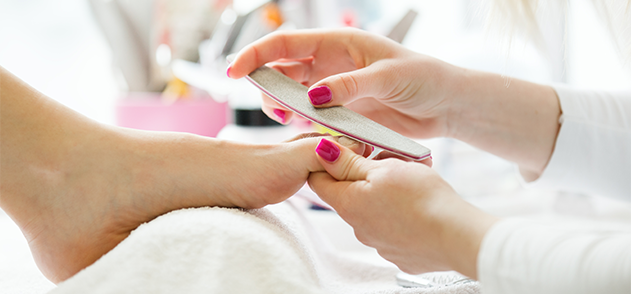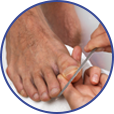HOME > ABOUT NAIL FUNGUS > CAUSES OF NAIL FUNGUS
Causes of
Nail Fungus

Nail fungus is highly contagious and simple to get. This nail health condition is quite common, affecting the lives and self-confidence of millions of people. There are multiple ways to catch nail fungus, and numerous ways to treat and prevent it. In this guide, you’ll learn the most prevalent causes of nail fungus infections.
Barefoot Walking in Public Places
Many nail fungus infections begin with trapped moisture and walking barefoot in some places makes it easier for this to occur. When you walk without socks and shoes in a public place such as a gym locker room, shower, or pool area, you put yourself at a greater risk of infection. Here, fungi can linger on surfaces for six months or more, making it very easy to pick up a nail fungus without realizing it. While barefoot walking in a clean environment may allow the nails to air out, it’s a different matter in public.
Nail Trauma
Your nails are subject to two kinds of trauma: acute and blunt. Acute trauma happens when nails are affected repeatedly, such as when a runner wears poorly fitted shoes. With every step in a tight-fitting shoe, you’re smashing your toenails. Blunt trauma happens when a heavy object falls on your foot, or when you stub your toe. Even if it is a one-time event, it makes you more vulnerable to nail fungus. Both types of injuries are painful, and both can cause a fungal infection.
Circulatory Problems
If you are a diabetic and have weak circulation in your feet, you’ll need to take special steps to avoid nail fungus. Those with circulatory problems may not immediately notice problems with the nails and feet, and poor circulation weakens the nails and inhibits the body’s natural healing response. Your nails are more vulnerable to infection, and the problem might be very difficult to treat. Our treatment guide provides valuable tips to help you eliminate nail fungus once and for all.
Pedicures
Everyone enjoys a good manicure or pedicure; it’s a wonderful way to pamper yourself and improve your appearance. However, a visit to the nail salon may put you at greater risk for a nail fungal infection. Like pools, locker rooms, and public showers, nail salons may be a fungal breeding ground if implements aren’t properly sterilized and sanitized. To avoid getting nail fungus, consider doing your pedicures at home, bring your own tools to the salon, or ask the nail tech to use disposable implements.
Artificial Nails
Along with receiving a manicure or pedicure, artificial nail wear may lead to nail fungus. Fake nails don’t give the real nail a chance to ventilate, and because fungus is caused by trapped moisture, that can be risky. Having artificial nails is even more dangerous because nail fungus can grow underneath them, and you may not notice the symptoms until it’s too late. Nail polish is another common culprit, and for similar reasons. If you like to wear nail polish or artificial nails, give yourself a few days in between applications to allow your nails to air out.
Immune Issues
Unfortunately, some nail fungus cases come from within. Some of the causes listed in our guide may have diminished effects on those with stout immune systems. Immune health is crucial when fighting and preventing nail fungus, and immune suppression may arise due to underlying health conditions, certain medicines, or a bad diet. Boosting your immune health makes it easier for your body to respond to these causes.
Nail Fungus: How Caontagious is it?
As mentioned earlier in this guide, nail fungus is extremely contagious, spreading from person to person or through contaminated clothing and footwear. Avoid sharing socks and shoes with someone who’s had a fungal infection. Many don’t realize they have nail fungus, and if you wear something of theirs, you put yourself at risk of infection. Things such as towels, nail polish, and nail care implements shouldn’t be shared, either. If you share a home with someone who has nail fungus, wear sandals or shoes in areas where they may have walked barefoot, such as the shower and bathroom. Nail fungus can be contagious even if it looks like it’s clearing up. If you’re dealing with a fungal infection under your nails, don’t share items and don’t allow anyone to touch the affected area until the fungus has been eliminated.
In Conclusion
When you’re dealing with nail fungus, it’s important to remember that treatment may take a while. No matter which treatment option you choose from our product comparison guide, consistency is key, and you should keep up with it until the infection is gone. By evaluating the appearance of your nails every day, you’re more likely to notice an infection in its initial stages. The earlier nail fungus is detected, the easier it is to treat, and the quicker it will clear up.
Know your nail fungus

What is it? How did you get it? How does it look? What color is it? Once you know these things, what should you do?
Get rid of nail fungus

No, nail fungus won't haunt you forever. Learn how to finally kill it with our guidance.
What to buy

We'll review various over-the-counter nail fungus treatments, highlighting what we liked and didn't like about each.

Your Source for Clear,
Healthy Nails. Expert Reviews,
Tips & Solutions. Empowering
You to Eliminate Nail Fungus
for Good!
